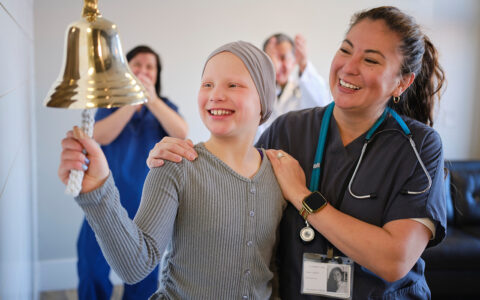Vanderbilt Center for Asthma researcher Tina Hartert, M.D., M.P.H., was part of a national investigative team, funded by the NIH, that has uncovered evidence that Black children have a higher chance of developing asthma than their white peers, regardless of neighborhood socioeconomic factors.
While past studies have shown that prevalence and severity of childhood asthma and wheezing are significantly higher in neighborhoods with increased poverty and urbanicity, this study provided evidence that Black and Hispanic children remained at higher risk compared with white children at all income levels.
“Both neighborhood- and individual-level characteristics and their root causes may be sources of respiratory health disparities.”
“This tells us that both neighborhood- and individual-level characteristics and their root causes may be sources of respiratory health disparities,” Hartert said.
Hartert worked with Harvard School of Public Health researchers and others to examine three decades of data on nearly 6,000 children in the United States to tease apart the relationships of race and ethnicity with neighborhood and socioeconomic risk factors in childhood asthma outcomes. Results were published last year in JAMA Pediatrics.
“Black children in the U.S. experience much higher incidence and four to five times higher mortality rates from asthma than white children, and disproportionately live in communities with economic deprivation,” Hartert said. “In addition to the high cost of trauma and the tragedy of preventable loss of life, this results in utilization of really high-cost health care resources, like emergency department visits and asthma hospitalizations.”
Census Tract-based Study
The Environmental Influences on Child Health Outcomes and Children’s Respiratory and Environmental Workgroup (CREW) consortiums, of which Hartert is a part, have recently reported differential rates of asthma when viewed by age, sex, race and calendar years. Asthma incidence was highest among children younger than 4 years old and among Black and Caribbean Hispanic children. However, the possible associations with neighborhood factors had not been examined.
“This study fills the gap, taking the conclusions from past research and separating out what may be attributable to race and ethnicity and what may be attributable to poverty and urbanicity,” Hartert said.
To do this, the investigative team used the CREW data from 5,809 children with asthma or wheezing from birth through age 11, sorted by census tract over three decades from 1980 to 2010.
The team analyzed the data by children’s sex, race and ethnicity, mother’s education, reported smoking during pregnancy, and parental history of asthma. To further stratify, they also looked at the data by geographic region, parents’ education, income, rent, housing value, whether there was a female head of household, any single-parent head of household, and employment status.
Across the cohort, 46 percent reported wheezing before age 2 years, and 26 percent reported persistent wheeze through age 11 years, with an earlier onset for Black and Hispanic children.
Race Remains Dominant
The analysis confirmed prior findings that children born in census tracts with a greater proportion of low-income households, population density, and poverty had increased asthma incidence.
They also found that neighborhood characteristics at birth, including a higher population density and poverty, increased the risk for asthma and wheezing. The risks of developing early and persistent wheezing were similar, though asthma incidence was attenuated after adjusting for individual-level covariates.
The novel finding was that Black and Hispanic children remained at higher risk compared with white children across in neighborhoods of all income levels.
Follow-up Studies
Hartert is continuing to lead studies identifying multi-level risk factors responsible for the differences in respiratory health to inform prevention efforts.
Although the researchers studied neighborhood characteristics at birth, Hartert says future analyses will also consider how residential mobility or neighborhood revitalization without relocation may influence changes in environmental exposures and how these, in turn, may alter asthma-related outcomes.
On a population level, changes that could improve asthma risk may include improved health care access, addition of green spaces, and the provision of healthier foods in food-desert spaces. Problems like air pollution, violent crime, and the stress in high-poverty urban environments remain as more difficult challenges.
On an individual level, Hartert says that obesity, poor diet, low activity levels, early exposure to allergens, and viral infections may all contribute to asthma development, offering additional goals for clinical interventions.
“This is important work for both directing future research and guiding policy and interventions at local levels to reduce disparities, at the same time that we work to reduce asthma risks for all children,” Hartert said.






